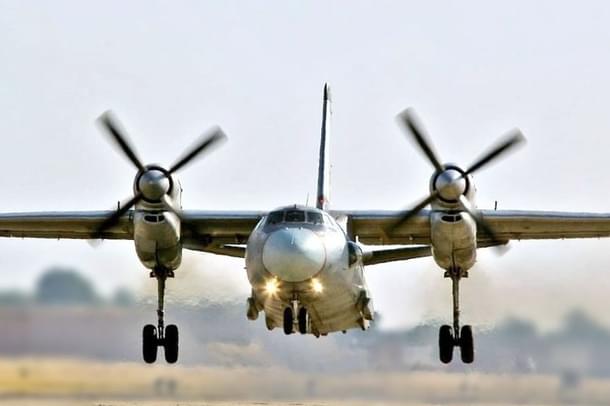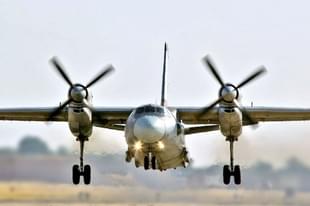Defence
How India Is Strengthening IAF Capabilities Along China Border
Jaideep Mazumdar
Jan 22, 2019, 12:55 PM | Updated 12:54 PM IST
Save & read from anywhere!
Bookmark stories for easy access on any device or the Swarajya app.


A significant but little-noticed development has just occurred in the North East. An Antonov-32 transport aircraft of the Indian Air Force (IAF) landed at Sikkim’s brand new greenfield Pakyong airport on Thursday. The airport was inaugurated by Prime Minister Narendra Modi a few months ago.
The landing of a military transport aircraft that can carry troops and military hardware in what is a civilian airport located about 60 kilometres away from the border with Tibet signals a firm intent to bolster military might for the defence of the northeastern region. Pakyong is the latest force-multiplier for the IAF, the other recent one being the Bogibeel Bridge spanning the Brahmaputra near the Chabua IAF station in Upper Assam (read this).
Since 2014, when the National Democratic Alliance (NDA) government came to power at the Centre, six advanced landing grounds (ALGs) in Arunachal Pradesh (of the seven that were in existence) have been upgraded and made operational. Another seven new ALGs will be constructed in the state. This will boost air defence capabilities in the entire region and make the IAF more than capable of meeting any threat from across the border. The IAF’s Sukhoi-30MKIs and other fighter aircraft, as well as the heavy duty carriers C-130J Super Hercules carrier and C-17 Globemasters, can land at these ALGs.
The United Progressive Alliance (UPA) government belatedly woke up to the importance of the existing seven ALGs (constructed by the British during the Second World War) in Arunachal Pradesh when reports of China having constructed many air bases in Tibet came to light in 2013. Until then, some of the ALGs in Arunachal Pradesh were being used only as helipads while the others had fallen into decay and were encroached on.
The ALGs that existed in Arunachal Pradesh were at Walong (eastern Arunachal), Vijaynagar (northeastern Arunachal bordering Myanmar), Tuting (northern Arunachal very close to border with Tibet), Pasighat (north-central Arunachal), Ziro (southwestern Arunachal), Aalo (central Arunachal) and Mechuka (north-central Arunachal close to Indo-Tibet border).
The ALG at Vijaynagar will be operational soon and its renovation to make it fit for fighter and transport aircraft posed a tough challenge since Vijaynagar does not have a road link. The nearest roadhead at Miao is about 90 km away and all construction materials are being transported on mules and by human labourers. Another new ALG at Tawang (western Arunachal bordering Tibet) is in the final stages of construction.
However, even after realising that the existing ALGs need to be upgraded and made operational for the IAF’s fighter jets and transport aircraft, the UPA government failed to allocate adequate funds and commence work on a war-footing. It was only after the NDA came to power that adequate funds (more than Rs 1,200 crore) were sanctioned and the pace of work accelerated.
By early 2016, three ALGs were ready and the remaining four were ready for fighter and transport aircraft by 2017. In April last year, Defence Minister Nirmala Sitharaman announced the government’s decision to build seven new ALGs in Arunachal, some of them very close to the India-China border. The Defence Minister made this announcement after witnessing Operation Gagan Shakti in Pasighat. The survey works on most of the new ALGs have been completed and construction has started.
Importance Of ALGs
ALGs are small, tactical combat airfields meant to increase the operational range of fighter aircraft. They also function as emergency landing strips, for supplying fuel, rations, ammunition and armament to frontline troops, and for refuelling and rearming of fighter planes. As such, ALGs play a crucial role during hostilities and are considered to be strategic force-multipliers.
The IAF’s Eastern Air Command has 15 stations under it at Agartala, Bagdogra, Umroi, Barrackpore, Chabua, Dum Dum, Hasimara, Jorhat, Kalaikunda, Kumbhirgram, Mohanbari, Borjhar, Panagarh, Tezpur and Tawang. Of these, some are permanent bases of the Sukhoi-30MKI and MiG fighters as well as helicopters and transport aircraft.
“The ALGs in the forward areas of Arunachal can not only be used for emergency landings and takeoffs, but also for refuelling and rearming. For instance, a Sukhoi 30MKI that takes off from Kalaikunda for a mission into China. The fighter has a 3,000 km range (Beijing is about 3,200 km away by air), so a refuelling at an ALG in Arunachal will increase its operational range. And after carrying out a mission, the aircraft can land, refuel and rearm at an ALG near the border and go on another mission without flying back to its base at Kalaikunda,” explained a senior officer posted at the Eastern Air Command headquarters in Shillong.
In fact, the IAF officer added, the fighter does not even have to land at an ALG since an Ilyushin-78 mid-air refueller stationed at one of the ALGs can refuel the fighter mid-air. Incidentally, India carried out its first-ever mid-air refuelling of the indigenous Tejas aircraft in September last year. The IL-78 can take off from an ALG in Arunachal and refuel fighter jets mid-air, thus saving a lot of time, and resources, that would have taken for the fighter to land, refuel and take-off.
Also, the ALGs are high-value strategic assets which, located as they are in well-fortified valleys, can shelter fighter jets, transport aircraft and helicopters in times of hostilities. Another crucial role that ALGs can play in times of emergencies is to facilitate quick evacuation of injured personnel as well as swift induction of soldiers, ammunition and military hardware. “These ALGs provide the cutting edge not only to the IAF, but also to the army. With all the ALGs becoming operational, we have become confident that any threat from across the border in this sector can be met more than adequately,” the IAF officer said.
Apart from hastening the pace of reconstruction of the existing ALGs and making them operational once again, the present NDA government’s decision to construct seven new ALGs in Arunachal is being viewed as a boon by the IAF. “It is like a dream come true. All these years, we have watched with dismay the Chinese military buildup in Tibet and other areas along the India-China border.
The ‘funds crunch’ excuse was always cited to turn down IAF’s plea for building assets in the North East. But this has changed now. Apart from Arunachal, building capacity at Pakyong (Sikkim) to handle military aircraft speaks volumes about the change in the attitude of the government and its determination to build military muscle in the North East,” said a retired Air Vice Marshal, who is now associated with a prominent think-tank.
Advantage India
Senior IAF officers point out that though China has built air strips in Tibet, the People's Liberation Army’s (PLA’s) air force suffers from a disadvantage there. Because of the high altitude of the Tibetan plateau, the payload and operational capacities of Chinese fighter jets gets severely compromised. That is, Chinese fighter jets cannot carry the optimum number of armaments or missiles and bombs, and also cannot carry fuel to their optimum capacities. Thus, their operational capabilities are compromised.
Chinese fighter jets Chengdu J-10 and Shenyang J-11, its third-generation lightweight multi-role fighter aircraft, suffer from severe engine problems while operating at high altitudes. The engine problems have led to crashes and though China obliquely claims to have solved engine problems, aviation experts contend that is not the case.
India’s air bases, located at much lower altitudes, thus offer a huge advantage to the IAF over the PLA’s air force. And it is this advantage that is being leveraged by the present NDA government, which is plugging the strategic gaps in the North East.




